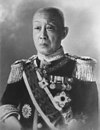General elections were held in Japan on 1 March 1904.[1][2] The Rikken Seiyūkai party remained the largest in the House of Representatives, winning 133 of the 379 seats.
| |||||||||||||||||||||||||||||||||||||||||||||||||||||||||||||||||||||||||
All 379 seats in the House of Representatives 190 seats needed for a majority | |||||||||||||||||||||||||||||||||||||||||||||||||||||||||||||||||||||||||
|---|---|---|---|---|---|---|---|---|---|---|---|---|---|---|---|---|---|---|---|---|---|---|---|---|---|---|---|---|---|---|---|---|---|---|---|---|---|---|---|---|---|---|---|---|---|---|---|---|---|---|---|---|---|---|---|---|---|---|---|---|---|---|---|---|---|---|---|---|---|---|---|---|---|
| |||||||||||||||||||||||||||||||||||||||||||||||||||||||||||||||||||||||||
| |||||||||||||||||||||||||||||||||||||||||||||||||||||||||||||||||||||||||
Electoral system
editThe 379 members of the House of Representatives were elected in 51 multi-member constituencies based on prefectures and cities. Voting was restricted to men aged over 25 who paid at least 10 yen a year in direct taxation.[3]
Results
edit| Party | Votes | % | Seats | +/– | |
|---|---|---|---|---|---|
| Rikken Seiyūkai | 217,691 | 33.47 | 133 | –42 | |
| Kensei Hontō | 170,319 | 26.19 | 90 | +5 | |
| Kōshin Club | 55,709 | 8.57 | 39 | +8 | |
| Jiyu Club | 31,772 | 4.89 | 18 | New | |
| Mumei Club | 31,197 | 4.80 | 25 | New | |
| Teikokutō | 27,244 | 4.19 | 19 | +2 | |
| Others | 116,419 | 17.90 | 55 | 0 | |
| Total | 650,351 | 100.00 | 379 | +3 | |
| Valid votes | 650,351 | 99.12 | |||
| Invalid/blank votes | 5,777 | 0.88 | |||
| Total votes | 656,128 | 100.00 | |||
| Registered voters/turnout | 762,445 | 86.06 | |||
| Source: Mackie & Rose, Voice Japan | |||||
Notes
edit- ^ As Chūsei Club
References
edit- ^ Thomas T Mackie & Richard Rose (1991) The International Almanac of Electoral History, Macmillan, p281
- ^ Garner, James Wilford (1904). "Record of Political Events". Political Science Quarterly. 19 (2): 367–368. doi:10.2307/2140296. ISSN 0032-3195. JSTOR 2140296.
- ^ Mackie & Rose, p276


